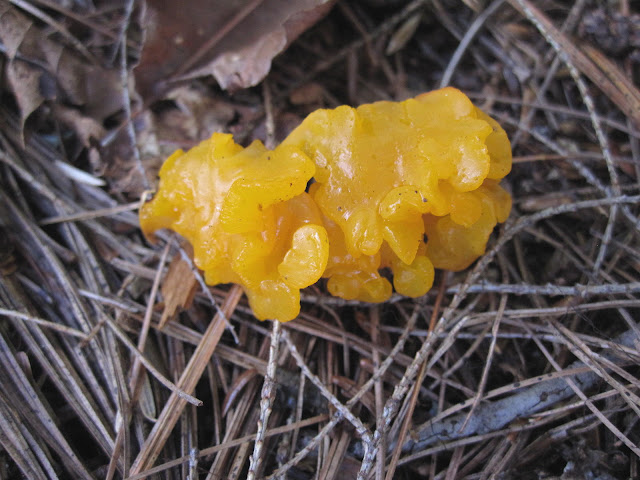After six weeks, I'm finally back on my feet and able to take my first kayak on Lake Wicwas, and a walk along the shores - and there's a lot going on! We had some gorgeous warm, sunny weather, and this calm morning revealed the presence of what's afflicting allergy sufferers, with a layer of pollen on surface of the lake.
While taking this picture, I noticed a small black fly suspended in the air, caught in an invisible spider web!
Here's the source of much of the pollen - the flowers in the oak trees are releasing their massive store of pollen. It's perhaps not as thick as the White Pine pollen that will be released soon, but there is a lot of it.
 |
| Red Oak Flowers |
From flowers at the highest point of the forest - the Red Oak - we go to the lowest floor and find one of the most remarkable flowers in the forest, the painted trillium.
I don't quite understand why there are hundreds of starflowers, and thousands of violets and mayflowers, but only one trillium along my usual hike. What is it about that one spot that nurtures a trillium that is so different from the rest of the forest? It also makes me realize how easy it is for a rare flower to be eradicated - just one person plucking or trampling a trillium every few years could be the end of them.
Along the shores of the lake I found lots of Hawthorn blooming. I first noticed the sweet fragrant smell coming form shore, and that led me to the flowers.
On this one you can see another fly caught in a spiders web!
And here's an insect that evaded the web and is helping with pollination.
Out on the lake itself the plants are growing rapidly. The Yellow Pond Lilies are already blooming where they get a lot of sun, and the lily pads are already giant.
The young water creatures are also growing quickly. I saw a water snake that is already almost a foot long, and this painted turtle - which is only about two and half inches long, though there's no scale to see that in this picture.
I saw lots of birds also, including the cormorant sitting high on its pine tree, the loon pair (scouting for a nesting site) and the geese. It looks like they have a child care center, as this one pair of adults was watching over at least 15 goslings.
When they go on family outings they somehow know which ones are theirs.
There are many Red-Wing Blackbirds providing lots of color to the marshes, both visually and aurally, as they bestow a large variety of loud, stark calls to all visitors.
A bird I don't think I've seen before at the lake is an Oriole. I had to go to the books to look this one up - it's a female.
 |
| Oriole, female |
She was flitting from shrub to shrub along the shoreline. Orioles like fruit, and she was in the blueberry bushes, but she wasn't finding any yet!
But the most exciting bird sighting was a pair of Broad-Winged Hawks that circled overhead for a long time. On the thermals of the hot afternoon (it was 84 yesterday, and 89 today!) the two of them soared directly above us. We first heard them calling in the trees, so we saw them as soon as they set sail, getting a great look at their wings and tails as they spread, flared, and narrowed them, maneuvering to find the best lift. It was too fascinating to leave to get a camera, but here's
a link to a picture that shows the sight. (I'm respecting the photographer's copyright request.)
One other really neat sight this week that I didn't capture on film (that is, silicon) was a Mink that hopped along our shoreline about 8:30 one morning. It went right along a path, then down the bank of the lake, and we followed it along the shore by the shaking blueberry bushes as it searched for frogs, chipmunks, or anything else it could find where land meets water.
There were a couple of less enjoyable sights this week. This one, man-made, of an old tire in the lake, was disappointing. It was right next to a pressure-treated 4x4 from the dock on Bryant Island that was cut out of the ice two years ago. This must be the spot where flotsam collects. I'll go back once the boat's in the lake - nothing to be done about it in a kayak....
The sight of tics on the grass is much easier to take, but still not fun to see!
They are so incredibly well adapted to catch anything that goes by them - look at the tiny barbs on their legs. Their legs move around slowly most of the time, but when I got really close, they starting vibrating madly to increase their batting average.
These tent caterpillars are also not a pretty sight. This nest was munching on a black cherry tree, already having stripped a number of branches.
I'll end this rather long rant with a beautiful sight of the coming season. I'm looking forward to seeing lots of people out on the lake next weekend as we remember those who gave the ultimate sacrifice so that we may enjoy the freedoms of this beautiful country.

















































